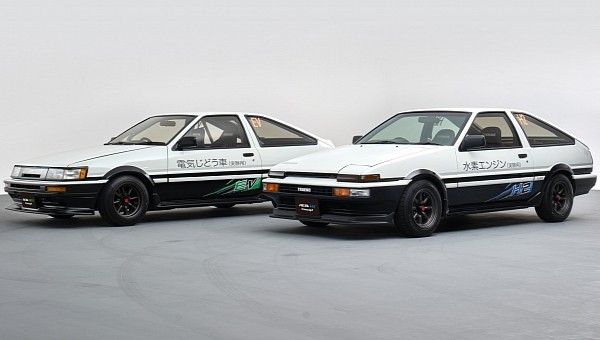Toyota's concept car lineup for the Tokyo Auto Salon 2023 revolves around the small yet cool GR Yaris, but the Japanese company also used the event to showcase a couple of intriguing Corolla AE86 classics powered by carbon-neutral drivetrains.
The first one goes by the name AE86 H2 Concept and it's described as a "hydrogen-engine vehicle." Simply put, it's powered by an internal combustion engine that burns hydrogen instead of gasoline. The car appears to feature a modified version of the AE86's 1.6-liter inline-four, but Toyota stresses that modifications to the fuel injectors, fuel pipes, and spark plugs "have been kept to the minimum."
Not surprisingly, the rear-mounted, high-pressure hydrogen storage tanks have been sourced from the Toyota Mirai. Introduced in late 2014, the Mirai is one of the first hydrogen fuel cell vehicles to be mass-produced and sold commercially.
The AE86 H2 Concept is inspired by the hydrogen-ICE race cars it developed for the Super Taikyu Series. Toyota began racing hydrogen-engine Corolla Sport models in 2021 and demonstrated a similarly-equipped GR Yaris H2 prototype in the World Rally Championship.
While the idea isn't exactly new, it proves that classic cars can retain their internal combustion engines while becoming carbon neutral.
The second Corolla AE86-based concept is an all-electric take on the iconic 1980s liftback. The car's internal combustion engine was replaced by an electric motor from the Tundra hybrid truck, a battery from the Prius, and an unnamed manual transmission. The company also points out that every bit of technology was sourced from commercially available Toyota and Lexus models.
It even goes as far as to say that the electrified AE86 offers "even greater driving pleasure than the original" but there are no performance numbers to run by.
Carbon-neutral drivetrains aside, both concept cars also feature revamped used seats and seatbelts, as well as seatbelt pads made from recycled materials. Design-wise, the AE86s look identical to their regular siblings save for "H2" and "EV" decals on the side sills and quarter windows.
Introduced in 1984, the AE86 series was rather short-lived, being discontinued in 1987. Offered in both coupe and liftback body styles, the AE86 shared underpinnings with the fourth-generation Toyota Corolla, also known as the E70.
Widely popular in Group A, Group N, and Rally racing, the AE86 also became a drifting legend in the 1980s. Of course, it's mostly famous for being featured in the highly popular Japanese manga and anime series 'Initial D.'
The AE86 was available in all markets with 1.6-liter four-cylinder engines. The mill delivered 128 horsepower (later 118 horses) in Europe and Japan and 112 horsepower in North America. U.S.-spec models were fitted with a modified engine to comply with California emissions regulations.
The cars are displayed in Tokyo alongside the GR Yaris Rally2 Concept and a pair of special GR Yaris RZ models dedicated to WRC drivers Sebastien Ogier and Kalle Rovanpera.
Not surprisingly, the rear-mounted, high-pressure hydrogen storage tanks have been sourced from the Toyota Mirai. Introduced in late 2014, the Mirai is one of the first hydrogen fuel cell vehicles to be mass-produced and sold commercially.
The AE86 H2 Concept is inspired by the hydrogen-ICE race cars it developed for the Super Taikyu Series. Toyota began racing hydrogen-engine Corolla Sport models in 2021 and demonstrated a similarly-equipped GR Yaris H2 prototype in the World Rally Championship.
While the idea isn't exactly new, it proves that classic cars can retain their internal combustion engines while becoming carbon neutral.
The second Corolla AE86-based concept is an all-electric take on the iconic 1980s liftback. The car's internal combustion engine was replaced by an electric motor from the Tundra hybrid truck, a battery from the Prius, and an unnamed manual transmission. The company also points out that every bit of technology was sourced from commercially available Toyota and Lexus models.
It even goes as far as to say that the electrified AE86 offers "even greater driving pleasure than the original" but there are no performance numbers to run by.
Carbon-neutral drivetrains aside, both concept cars also feature revamped used seats and seatbelts, as well as seatbelt pads made from recycled materials. Design-wise, the AE86s look identical to their regular siblings save for "H2" and "EV" decals on the side sills and quarter windows.
Introduced in 1984, the AE86 series was rather short-lived, being discontinued in 1987. Offered in both coupe and liftback body styles, the AE86 shared underpinnings with the fourth-generation Toyota Corolla, also known as the E70.
Widely popular in Group A, Group N, and Rally racing, the AE86 also became a drifting legend in the 1980s. Of course, it's mostly famous for being featured in the highly popular Japanese manga and anime series 'Initial D.'
The AE86 was available in all markets with 1.6-liter four-cylinder engines. The mill delivered 128 horsepower (later 118 horses) in Europe and Japan and 112 horsepower in North America. U.S.-spec models were fitted with a modified engine to comply with California emissions regulations.
The cars are displayed in Tokyo alongside the GR Yaris Rally2 Concept and a pair of special GR Yaris RZ models dedicated to WRC drivers Sebastien Ogier and Kalle Rovanpera.

